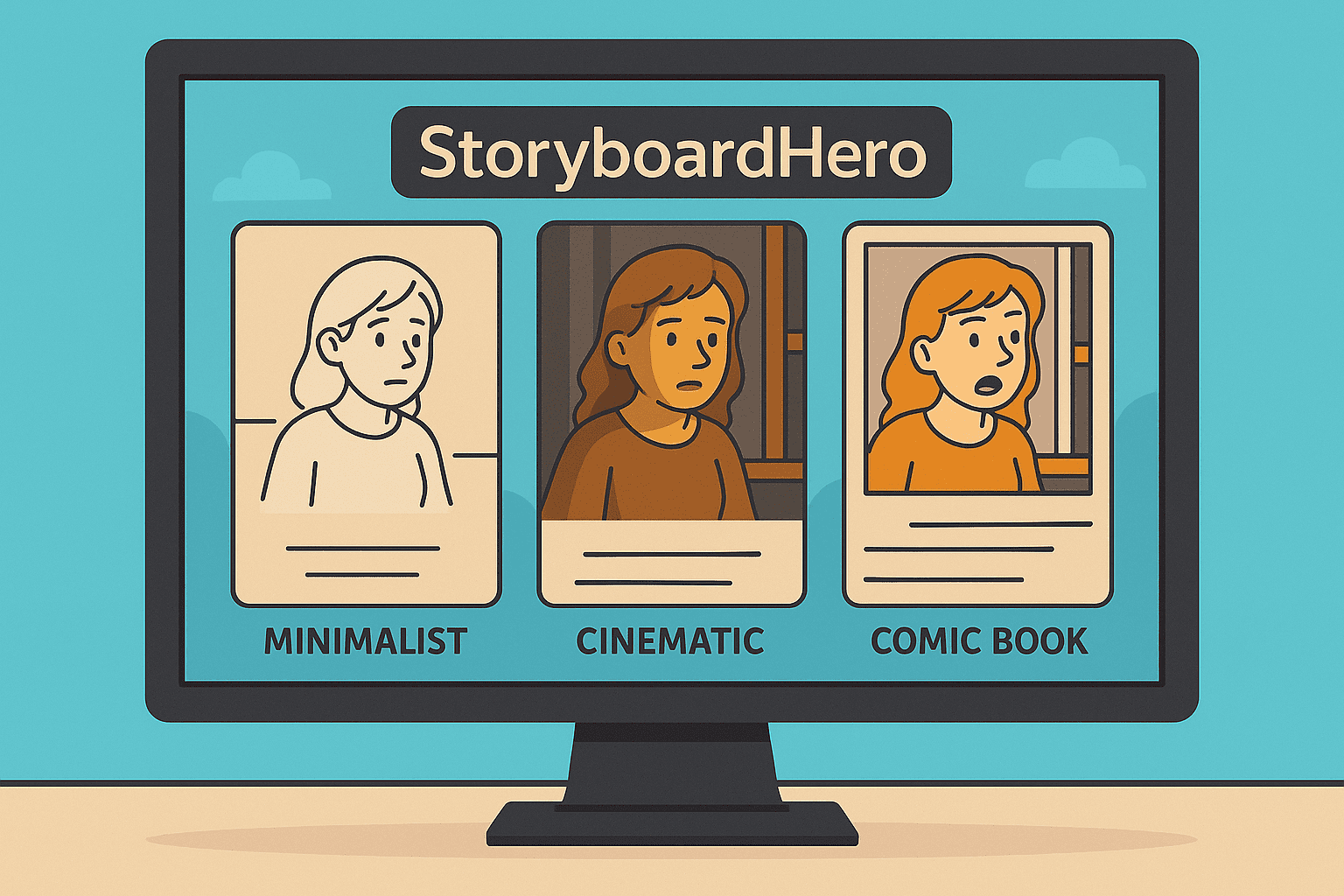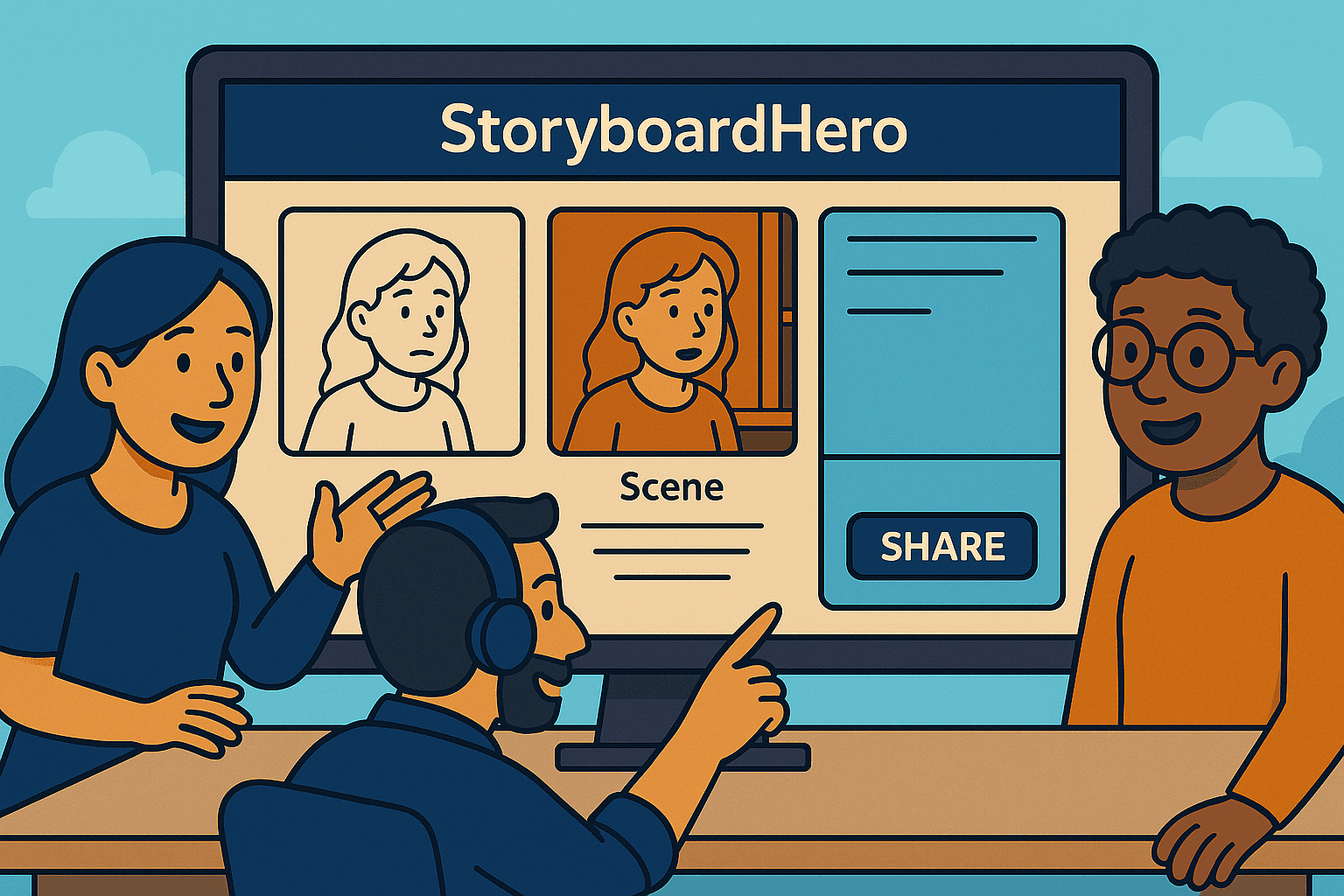Revolutionize Your Visual Storytelling with Dynamic Storyboard Styles
Table of Contents
- Understanding Storyboard Styles
- Popular Storyboard Styles for Modern Creators
- How an Online Storyboarding Tool Enhances Your Process
- StoryboardHero: AI-Powered Storyboarding Revolution
- Real-World Applications of Different Storyboard Styles
- Choosing the Right Style for Your Project
- Maximizing Collaboration with Digital Storyboards
- Frequently Asked Questions
Understanding Storyboard Styles

Storyboard styles are the visual languages that bring your scripts to life before filming begins. These varied approaches to visual pre-production determine how effectively your story communicates with viewers and production teams alike. With the right storyboard styles, you can transform abstract concepts into concrete visual plans that guide your entire production process. Modern filmmakers and content creators increasingly rely on innovative storyboard styles to save time, reduce costs, and align creative visions.
Using an online storyboarding tool like StoryboardHero allows you to experiment with multiple styles without the traditional constraints of manual illustration. This flexibility ensures your pre-visualization matches your creative intent while maintaining production efficiency.
Popular Storyboard Styles for Modern Creators
Minimalist Sketch Style
The minimalist approach focuses on essential elements using simple lines and shapes. This storyboard style works particularly well for:
- Quick concept validation
- Projects with tight deadlines
- Early-stage pitches where detailed visuals aren’t yet required
Cinematic Frame Style
This detailed storyboard style closely resembles final shots with attention to:
- Lighting and shadows
- Camera angles and movements
- Depth and perspective
Comic Book Style
Borrowing from sequential art traditions, this dynamic style features:
- Bold outlines and expressive characters
- Varied panel layouts for pacing control
- Visual sound effects and motion lines
Mood Board Style
Perfect for establishing atmosphere, this style incorporates:
- Color palettes that convey emotional tone
- Texture and environmental elements
- Reference imagery that captures the intended feel
Each of these storyboard styles serves different purposes in the pre-production workflow, and the best online storyboarding tools allow you to switch between them as your project evolves.
How an Online Storyboarding Tool Enhances Your Process
Traditional storyboarding can be time-consuming and resource-intensive. Modern online storyboarding tools revolutionize this process by offering:
- Speed: Generate complete storyboards in minutes rather than days
- Flexibility: Easily modify scenes without starting from scratch
- Accessibility: Work from anywhere with cloud-based collaboration
- Consistency: Maintain visual continuity throughout your project
The evolution from manual to digital storyboarding represents more than just technological advancement—it’s a fundamental shift in how visual stories are conceptualized and shared.

StoryboardHero: AI-Powered Storyboarding Revolution
StoryboardHero brings cutting-edge AI technology to storyboard creation, taking the online storyboarding tool concept to new heights. This innovative platform:
- Transforms scripts automatically: Simply input your script, and the AI generates professionally styled storyboards
- Offers style customization: Choose from various storyboard styles to match your project’s needs
- Enables real-time collaboration: Share, comment, and revise with your team instantly
- Provides export flexibility: Download in formats optimized for presentations or production
The intuitive interface makes it accessible for both industry veterans and newcomers, democratizing the storyboarding process across skill levels and disciplines.
From Script to Screen: The AI Advantage
The AI engine powering StoryboardHero understands narrative context, translating written descriptions into visually appropriate scenes. This means your storyboard styles accurately reflect not just what happens in each scene, but the emotional and atmospheric qualities described in your script.
Real-World Applications of Different Storyboard Styles
Advertising Campaigns
Ad agencies leverage diverse storyboard styles to present concepts to clients before committing to expensive production. A recent campaign for Toyota used StoryboardHero’s platform to visualize six different creative approaches in just one day.
E-Learning and Training Videos
Instructional designers use simplified storyboard styles to plan educational content, ensuring information flows logically before recording begins.
Social Media Content
For platforms like TikTok, Instagram, and LinkedIn, creators use fast-turnaround storyboard styles to plan multiple pieces of content efficiently.
Choosing the Right Style for Your Project
Selecting appropriate storyboard styles depends on several factors:
- Project timeline: Tighter deadlines may require simpler styles
- Budget considerations: Detailed storyboards can prevent costly on-set changes
- Team experience: Consider who needs to interpret your storyboards
- Client expectations: Some clients prefer detailed visuals, while others focus on concepts
A flexible online storyboarding tool lets you adjust your approach as needed, starting with rough concepts and refining into detailed sequences as approval milestones are reached.
Maximizing Collaboration with Digital Storyboards
Effective teamwork is essential for successful productions. Modern Storyboard styles in digital formats facilitate collaboration by:
- Allowing simultaneous access for distributed teams
- Tracking changes and maintaining version history
- Enabling direct feedback on specific frames
- Integrating with other production planning tools
With StoryboardHero’s online storyboarding tool, creative directors can:
- Share concepts with clients for immediate feedback
- Adjust storyboard styles based on stakeholder input
- Finalize production plans with confidence
- Build comprehensive shot lists directly from approved storyboards
Frequently Asked Questions
What are the most common storyboard styles for beginners?
Beginners often start with simplified thumbnail sketches that focus on composition and movement rather than detail. An online storyboarding tool with templates can help newcomers structure their visual thinking effectively.
How detailed should my storyboard be?
The level of detail in your storyboard styles should match your project needs. Key sequences often benefit from more detailed treatment, while transitional scenes may need only basic visualization.
Can storyboard styles vary within a single project?
Absolutely! Many directors use different storyboard styles for different sequence types—detailed boards for action scenes and simpler layouts for dialogue, for instance.
How do online storyboarding tools compare to traditional methods?
Online storyboarding tools offer significant advantages in speed, collaboration, and revision capabilities, though some directors still prefer hand-drawn boards for certain projects. Many productions now use a hybrid approach.
What makes StoryboardHero different from other online storyboarding tools?
StoryboardHero’s AI-powered script analysis creates contextually appropriate visuals automatically, dramatically reducing the time from concept to visualization compared to traditional online storyboarding tools.
Ready to transform your scripts into compelling visual stories? Try StoryboardHero today and discover how different storyboard styles can elevate your production process.
